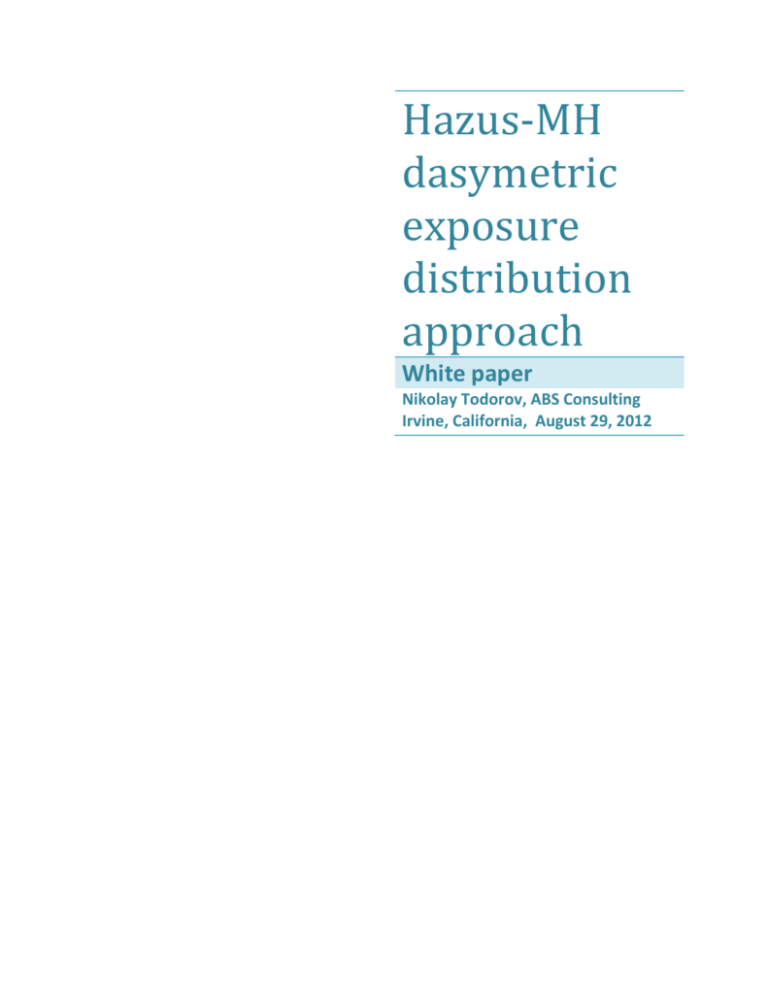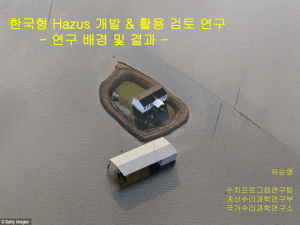Hazus-MH dasymetric exposure distribution
advertisement

Hazus-MH dasymetric exposure distribution approach White paper Nikolay Todorov, ABS Consulting Irvine, California, August 29, 2012 August 29, 2012 Table of Contents Objective ....................................................................................................................................................... 2 Proposed approach ....................................................................................................................................... 2 Examples ....................................................................................................................................................... 4 Study Region: Bristol, RI (_BristolRI) dasymetric distribution .................................................................. 5 Study Region: Bristol, RI (__BristolRI) homogenous distribution ............................................................. 7 The work ahead ............................................................................................................................................ 9 Conclusion ................................................................................................................................................... 10 Credits ......................................................................................................................................................... 11 References .................................................................................................................................................. 11 Table of Figures Figure 1 - The complete NLCD LULC classification ........................................................................................ 2 Figure 2 – ABS-created dasymetric workflow model.................................................................................... 4 Figure 3 – Map of Direct Economic Loss for Buildings, dasymetric distribution .......................................... 5 Figure 4 - Report of Direct Economic Loss for Buildings, dasymetric distribution ....................................... 5 Figure 5 - Debris Total Tons, dasymetric distribution ................................................................................... 6 Figure 6 - Shelter Displaced Population, dasymetric distribution ................................................................ 6 Figure 7 – Map of Direct Economic Loss for Buildings, homogenous distribution ....................................... 7 Figure 8 - Report of Direct Economic Loss for Buildings, homogenous distribution .................................... 7 Figure 9 - Debris Total Tons, homogenous distribution ............................................................................... 8 Figure 10 - Shelter Displaced Population, homogenous distribution ........................................................... 8 Figure 11 - CBs that have exposure, but don’t have rectified LULCs pixels .................................................. 9 Figure 12 - CBs that don’t have exposure, but have rectified LULCs pixels ................................................ 10 Hazus-MH dasymetric exposure distribution approach 1 Objective Hazus-MH, “a nationally applicable standardized methodology that contains models for estimating potential losses from earthquakes, floods, and hurricanes”1 by FEMA, is in its second decade of existence and reaching the original paradigm’s maturity, as well as facing the new paradigm challenges. As the number of Hazus-MH users continues to grow including internationally, so do the types of uses. In order to keep its relevance Hazus-MH needs to evolve and answer to the increasing demands of its users. One such Hazus-MH Flood Model challenge is how to adapt the original homogenous Census Block (CB) building and content exposure distribution to the only build-up locations, used in the General Building Stock (GBS) analysis? In the past several years the Hazus-MH Flood users have been avoiding the GBS analysis in favor of the User-Defined Facility (UDF) analysis in an attempt to increase the flood risk assessment location accuracy by avoiding the inherent inaccuracy associated with the homogenous distribution. This white paper reviews the latest trends in the use of dasymetric mapping approach4 and how Hazus can benefit from it while keeping its methodological, code and data integrity. Proposed approach At the March 2011 Hazus Flood Oversight Committee meeting at the National Institute for Building Science (NIBS), Washington, DC I had the pleasure to discuss with several committee members (Gene Longenecker, Nick Lutz, Eric Tate) the latest cartographic trends and advancements of the dasymetric mapping and how those might benefit Hazus. A brief definition of a dasymetric mapping – it is a thematic cartographic technique that allows using underlying ancillary data to enhance distribution [and density] maps. The Proof of Concept (POC) Hazus-MH Flood Model dasymetric exposure distribution approach is based on the Multi-Resolution Land Characteristics (MRLC)2 Consortium’s National Land Cover Database 2006 (NLCD2006)3. The NLCD2006 is the most recently rectified complete Land Use Land Cover (LULC) classification. NLCD2006 is a LULC classification scheme that has been applied consistently across the conterminous United States at a spatial resolution of 30 meters. NLCD2006 is based primarily on the unsupervised classification of Landsat Enhanced Thematic Mapper+ (ETM+) circa 2006 satellite data3. Figure 1 - The complete NLCD LULC classification Hazus-MH dasymetric exposure distribution approach 2 Class | Value Developed Classification Description areas characterized by a high percentage (30% or greater) of constructed materials (e.g. asphalt, concrete, buildings, etc.). 21 Developed, Open Space - areas with a mixture of some constructed materials, but mostly vegetation in the form of lawn grasses. Impervious surfaces account for less than 20% of total cover. These areas most commonly include large-lot single-family housing units, parks, golf courses, and vegetation planted in developed settings for recreation, erosion control, or aesthetic purposes. 22 Developed, Low Intensity - areas with a mixture of constructed materials and vegetation. Impervious surfaces account for 20% to 49% percent of total cover. These areas most commonly include single-family housing units. 23 Developed, Medium Intensity – areas with a mixture of constructed materials and vegetation. Impervious surfaces account for 50% to 79% of the total cover. These areas most commonly include single-family housing units. 24 Developed High Intensity -highly developed areas where people reside or work in high numbers. Examples include apartment complexes, row houses and commercial/industrial. Impervious surfaces account for 80% to 100% of the total cover. Planted/Cultivated areas characterized by herbaceous vegetation that has been planted or is intensively managed for the production of food, feed, or fiber; or is maintained in developed settings for specific purposes. Herbaceous vegetation accounts for 75% to 100% of the cover. 81 Pasture/Hay – areas of grasses, legumes, or grass-legume mixtures planted for livestock grazing or the production of seed or hay crops, typically on a perennial cycle. Pasture/hay vegetation accounts for greater than 20% of total vegetation. 82 Cultivated Crops – areas used for the production of annual crops, such as corn, soybeans, vegetables, tobacco, and cotton, and also perennial woody Hazus-MH dasymetric exposure distribution approach 3 crops such as orchards and vineyards. Crop vegetation accounts for greater than 20% of total vegetation. This class also includes all land being actively tilled. For the purpose of this white paper ABS selected Developed and Planted/Cultivated classes (LULCs 21, 22, 23, 24, 81, and 82) as potential build-up areas. An excerpt of the 6 LULCs detailed description is shown in the table above. Selecting the Developed class, containing the first four LULCs, is obvious. The reason we added Planted/Cultivated class (81, 82 LULCs) to the potential build-up area was based on Remote Sensing spot checks in rural Rhode Island where certain structures existed in the planted/cultivated class. The proposed dasymetric approach is based on dissolving the six (21, 22, 23, 24, 81, and 82) NLCD2006 LULCs to polygons and spatially intersecting those with the TIGER-based Census 2000 Blocks. The resultant CB coverage contains the most likely build-up area while excluding the Barren land, Forrest, Shrubland, Herbaceous, and Wetland classes. Examples To efficiently process the repetitive state dasymetric distribution feature class ABS created an initial selfcontained model in the Esri Model Builder. The dasymetric model that ABS created (shown below) upon entering the input parameters, workspace, state data location and NLCD raster and LULC codes generates the final hzCensusBlock coverage preserving the original attribute data. To compare the homogenous vs dasymetric distributions ABS selected riverine hazard in Bristol county in the state of Rhode Island. To eliminate the uncertainties caused by OS version, MDAC, DEM resolution, Esri and Hazus builds, the two Study Regions (dasymetric and homogenous) were aggregated on the same computer, using 0.5 sq mi Drainage Area, and selecting identical reaches. Figure 2 – ABS-created dasymetric workflow model Hazus-MH dasymetric exposure distribution approach 4 Study Region: Bristol, RI (_BristolRI) dasymetric distribution Scenario: Riverine only (rivOnly) Figure 3 – Map of Direct Economic Loss for Buildings, dasymetric distribution Direct Economic Losses for Buildings All values are in thousands of dollars August 23, 2012 Capital Stock Los s es Building Loss Contents Loss Incom e Los s es Inv entory Loss Building Loss Ratio % Relocation Loss Capital Related Loss Wages Losses Rental Income Loss Total Loss Rhode Is land Bristol 2,814 2,754 26 0.50 4 1 5 0 5,604 Total 2,814 2,754 26 0.50 4 1 5 0 5,604 Scenario Total 2,814 2,754 26 0.50 4 1 5 0 5,604 Totals only reflect data for those census tracts /blocks included in the user's study region and w ill reflect the entire county/state only if all of the census blocks for that county/state w ere selected at the time of study region creation. Study Region: Scenario: Return Period: _BristolRI rivOnly 500 Page : 1 of 1 Figure 4 - Report of Direct Economic Loss for Buildings, dasymetric distribution Hazus-MH dasymetric exposure distribution approach 5 Figure 5 - Debris Total Tons, dasymetric distribution Figure 6 - Shelter Displaced Population, dasymetric distribution Hazus-MH dasymetric exposure distribution approach 6 Study Region: Bristol, RI (__BristolRI) homogenous distribution Scenario: Riverine only (rivOnly) Direct Economic Loss for Buildings Full Replacement: Figure 7 – Map of Direct Economic Loss for Buildings, homogenous distribution Direct Economic Losses for Buildings All values are in thousands of dollars Augus t 23, 2012 Capital Stock Los s es Building Loss Contents Loss Incom e Los s es Inv entory Loss Building Loss Ratio % Relocation Loss Capital Related Loss Wages Losses Rental Income Loss Total Loss Rhode Is land Bristol 4,472 4,516 52 0.70 9 6 11 0 9,066 Total 4,472 4,516 52 0.70 9 6 11 0 9,066 Scenario Total 4,472 4,516 52 0.70 9 6 11 0 9,066 Totals only reflect data for those census tracts /blocks included in the user's study region and w ill reflect the entire county/state only if all of the census blocks for that county/state w ere selected at the time of study region creation. Study Region: Scenario: Return Period: __BristolRI rivOnly 500 Page : 1 of 1 Figure 8 - Report of Direct Economic Loss for Buildings, homogenous distribution Hazus-MH dasymetric exposure distribution approach 7 Figure 9 - Debris Total Tons, homogenous distribution Figure 10 - Shelter Displaced Population, homogenous distribution Hazus-MH dasymetric exposure distribution approach 8 The work ahead It is of utmost importance the modified State Data CBs to maintain 1-to-1 cardinality with the original State Data CBs. In other words, the dasymetric State Data has to contain not only the same count of CBs, but also those CBs have to be the exact same CBs as the original State Data. No duplicates, no additions, no omissions. Otherwise the Study Region aggregation ends abnormally. During the RI POC GIS processing of the NLCD 2006 and Census TIGER 2000 feature classes we came across a small set of problem CBs that could be categorized in two groups: 1. CBs that have exposure, but don’t have rectified LULCs pixels, and 2. CBs that don’t have exposure, but have rectified LULCs pixel(s). Researching these two discrepancies and brainstorming with committee members Nick Lutz and Eric Tate the possible reasons could be as follows: 1. CBs that have exposure, but don’t have rectified LULCs pixels - this perhaps is an issue where the unsupervised classification of the NLCD2006 Landsat Enhanced Thematic Mapper+ might have missed classifying certain pixel(s). As a result we propose taking one of the following corrective measures: a. Add back the whole CB polygon (simple); b. Add back part of the CB polygon after spatially subtracting the non-build-up classes, namely Water, Barren land, Forrests, Shrubland, Herbaceous, and Wetland classes (simple, but time consuming); Figure 11 - CBs that have exposure, but don’t have rectified LULCs pixels Hazus-MH dasymetric exposure distribution approach 9 2. CBs that don’t have exposure, but have rectified LULCs pixels – we attributed this to the potential temporal change in the CB, (Census 2000 vs NLCD 2006). In this case there are two possible outcomes: a. Leave the exposure as-is, ignore NLCD (simple). This preserves the temporal (here circa 2000) exposure data integrity; b. Attempt to obtain exposure data by flood specific occupancy for the CB from other sources (difficult, and very time consuming). Figure 12 - CBs that don’t have exposure, but have rectified LULCs pixels Looking ahead the Census/NLCD discrepancies would have to be resolved to preserve the Hazuscommon and Flood-only data integrity intact. Dasymetric pre-processing of most (small and average size) states could be and should be automated. However, for larger states, such as TX, CA, NY the automated processing fail due to hardware limitations, and would require manual workaround to the hardware limitation problem. Conclusion Based on a dasymetric exposure distribution approach the following important goals will be achieved: 1. Keep the existing Hazus Flood methodology intact; 2. Keep the existing Hazus Flood code base intact; 3. Keep the existing Hazus-common and Flood-only State Data intact. Hazus-MH dasymetric exposure distribution approach 1 0 Also, we recognize that the dasymetric exposure distribution approach shifts the flood risk assessment paradigm by including in the analysis only the build-up geographical areas. The initial, limited dasymmetric results indicate a loss reduction as much as 40-50% as compared to the homogenous exposure distribution approach. We recommend automating a process for a one-time dasymetric CB exposure distribution preprocessing of the whole conterminous United States. This will assure the same fast Hazus Flood GBS analysis processing time while taking advantage of the more accurate location-based flood risk assessment. We further recommend performing a larger scale (100 counties, ~3%) sensitivity analysis based on both approaches as a precursor to addressing the 2009 Average Annualized Flood Loss nationwide study results. Credits I would like to thank the members of the Hazus Flood Oversight Committee Eric Tate, Gene Longenecher, Nick Lutz and Philip Schneider for their encouragement, ideas, critique and contribution; ABS Hazus Flood Development Team, and Kavin Keratikasama in particular for the work on the initial model design. References FEMA. (n.d.). Hazus - FEMA. Retrieved from Federal Emergency Management Agency: http://www.fema.gov/protecting-our-communities/hazus MRLC. (n.d.). MRLC Home. Retrieved from Multi-Resolution Land Characteristics Consortium: http://www.mrlc.gov/ MRLC. (n.d.). NLCD2006. Retrieved from National Land Cover Database 2006: http://www.mrlc.gov/nlcd2006.php Wikipedia, the free encyclopedia. (n.d.). Retrieved from Dasymetric map: http://en.wikipedia.org/wiki/Dasymetric_map Hazus-MH dasymetric exposure distribution approach 1 1







